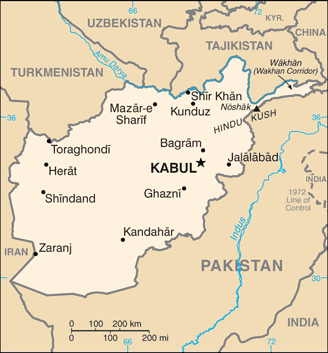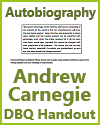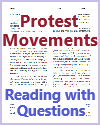| Political Map of Afghanistan |
|---|
| www.studenthandouts.com ↣ World Geography ↣ Asia ↣ South-central Asia ↣ Afghanistan |
 Political Geography Political Geography▢ Afghanistan is bordered by Iran, Turkmenistan, Uzbekistan, Tajikistan, China, and Pakistan. ▢ Its capital city is Kabul. ▢ Other major Afghan cities include Kandahar, Zaranj, Jalalabad, and Kunduz. Brief Political History of Afghanistan ▢ In 1747, Ahmad Shah DURRANI founded Afghanistan by unifying the Pashtun tribes. ▢ Afghanistan operated as a buffer between the British Empire and the Russian Empire until, in 1919, it won independence from notional British control. ▢ A short fling with democracy ended in 1973 with a coup and in 1978 with a Communist counter-coup. ▢ In 1979, the Soviet Union invaded to support the weak Afghan Communist regime, sparking a lengthy and destructive war. ▢ In 1989 (shortly before the Soviet Union itself crumbled), the USSR withdrew from Afghanistan under relentless pressure by anti-Communist mujahedin rebels being supported by international forces, including the United States. ▢ Kabul (the capital city) finally fell to the Taliban in the fall of 1996 after a series of subsequent civil wars. The Taliban is an Islamic fundamentalist, Pakistani-sponsored movement. It emerged in 1994 to end Afghanistan's civil war and anarchy. ▢ The attacks which occurred on the United States on September 11, 2001, were linked to Osama bin Laden, a Taliban leader who had been supported by the United States during the Afghan civil war. Following the 9/11 terrorist attacks in New York City and Washington, D.C., an American, Allied, and anti-Taliban Northern Alliance military action brought down the Taliban for sheltering Osama bin Laden. ▢ In 2001, the United Nations-sponsored Bonn Conference set up a process for Afghanistan's political reconstruction. This process included the adoption of a new constitution, a presidential election in 2004, and National Assembly elections in 2005. ▢ Hamid Karzai became the first democratically elected president of Afghanistan in December of 2004. The National Assembly was inaugurated the following December (2005). ▢ Hamid Karzai was re-elected in August of 2009 for a second term. Gains have been made toward building a stable central government. However, a resurgent Taliban and continuing instability in the countryside - particularly in the south and in the east - remain serious challenges for the new Afghan Government. ▢ Osama bin Laden was killed by Seal Team Six (of the U.S. Navy Seals) on May 2, 2011, in Abbottabad, Pakistan. Afghanistan served as a buffer state between the British and Russian empires until the country won independence from notional British control in 1919, following World War I. The capital city of Afghanistan is Kabul. Afghanistan is bordered by Iran, Pakistan, China, Tajikistan, Uzbekistan, and Turkmenistan. The majority religion is Islam. |
 |  |  |  |  |  |
| www.studenthandouts.com ↣ World Geography ↣ Asia ↣ South-central Asia ↣ Afghanistan |








